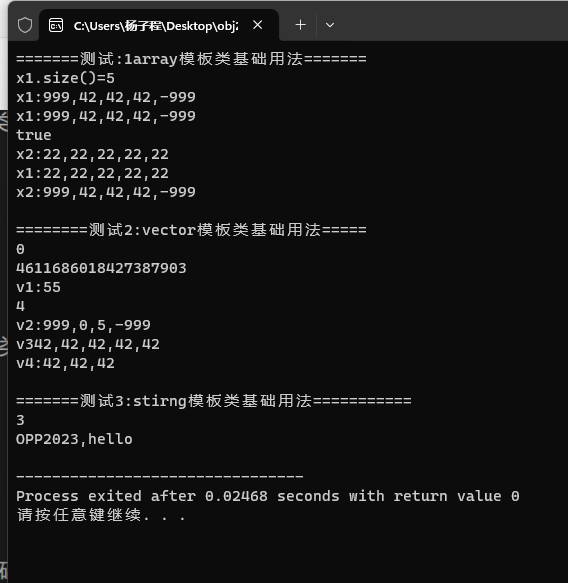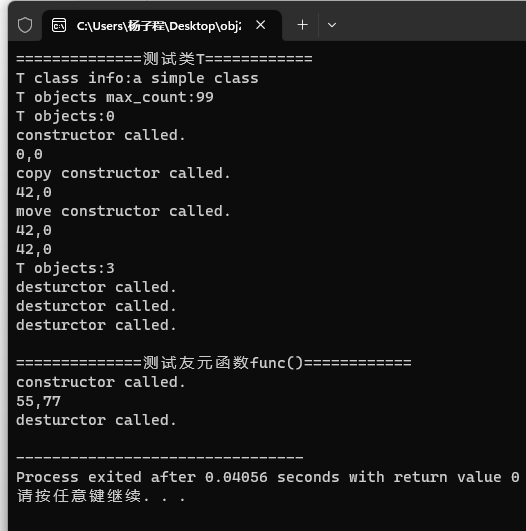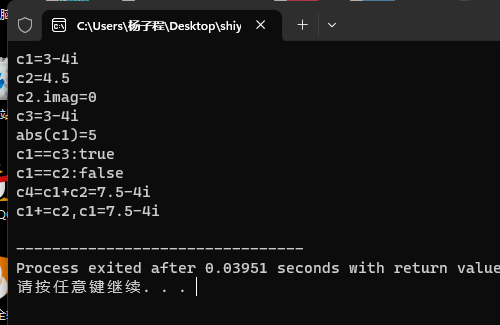#include <iostream> #include <string> #include <vector> #include <array>
// 通用函数(此处是模板函数)用于输出容器中的元素,支持范围for(范围for循环,是一种用于遍历容器、数组和其他序列容器的现代C++迭代循环结构。它提供了一种更简洁和易读的方法来遍历容器的元素,而无需手动处理迭代器或索引。)循环 template <typename T> void output1(const T &obj) { for (auto i : obj) std::cout << i << ","; std::cout << "\b \n"; // 删除末尾多余的逗号并换行 } // 输出容器中的元素,使用迭代器遍历 template <typename T> void output2(const T &obj) { for (auto p = obj.begin(); p != obj.end(); ++p) std::cout << *p << ","; std::cout << "\b \n"; // 删除末尾多余的逗号并换行 } void test_array() { using namespace std; array<int, 5> x1; // 创建包含5个int的数组对象 cout << "x1.size()=" << x1.size() << endl; x1.fill(42); // 填充数组元素为42 x1.at(0) = 999; // 修改指定位置第一个的元素 x1[4] = -999; // 修改指定位置第五个的元素 cout << "x1:"; output1(x1); // 第一种方法输出数组元素 cout << "x1:"; output2(x1); // 第二种方法输出数组元素 array<int, 5> x2(x1); // 使用另一个数组初始化新数组(此处不能用{}可能由于版本问题) cout << boolalpha << (x1 == x2) << endl; // 判断两个数组是否相等如果是返回ture x2.fill(22); // 填充x2的元素为22 cout << "x2:"; output1(x2); swap(x1, x2); // 交换两个数组x1,x2 cout << "x1:"; output1(x1); cout << "x2:"; output1(x2); } void test_vector() { using namespace std; vector<int> v1; cout << v1.size() << endl; cout << v1.max_size() << endl; v1.push_back(55); cout << "v1:"; output1(v1); // 输出v1全部元素 vector<int> v2{1, 0, 5, 2}; v2.pop_back(); // 用函数pop_back删除最后一个元素 v2.erase(v2.begin()); // 删除第一个元素 v2.insert(v2.begin(), 999); // 在开头插入元素 v2.insert(v2.end(), -999); // 在末尾插入元素 cout << v2.size() << endl; cout << "v2:"; output2(v2); vector<int> v3(5, 42); // 创建一个包含5个42的元素 cout << "v3"; output1(v3); vector<int> v4(v3.begin(), v3.end()-2); // 从v3的开头复制3个元素给v4 cout << "v4:"; output1(v4); } void test_string() { using namespace std; string s1{"opp"}; cout << s1.size() << endl; for (auto &i : s1) i -= 32; // 将字符转换为大写 s1 += "2023"; // 字符串拼接采用直接加的形式 s1.append(",hello"); // 追加字符串采用s1.append append函数 cout << s1 << endl; } int main() { using namespace std; cout << "=======测试1:array模板类基础用法======\n"; test_array(); cout << "\n=======测试2:vector====\n"; test_vector(); cout << "\n=======测试3:string====\n"; test_string(); return 0; }

//任务2 #include <iostream> #include <complex> void test_std_complex() { using namespace std; // 创建复数对象用complex<double>创建 complex<double> c1{3, 4}; complex<double> c2{4.5}; // 创建一个常量复数对象 const complex<double> c3{c2}; // 输出复数对象c1,c2,c3的值 cout << "c1=" << c1 << endl; cout << "c2=" << c2 << endl; cout << "c3=" << c3 << endl; // 输出复数对象的实部和虚部 cout << "c3.real=" << c3.real() << ", c3.imag=" << c3.imag() << endl; // 执行复数的加法和减法 cout << "c1 + c2 = " << c1 + c2 << endl; cout << "c1 - c2 = " << c1 - c2 << endl; // 计算复数c1的模 cout << "abs(c1) = " << abs(c1) << endl; // 使用boolalpha输出复数对象的相等性比较结果 cout << boolalpha; cout << "c1 == c2: " << (c1 == c2) << endl; cout << "c3 == c2: " << (c3 == c2) << endl; complex<double> c4 = 2; // 创建并初始化一个复数对象 cout << "c4=" << c4 << endl; c4 += c1; // 复数对象的复合赋值运算 cout << "c4=" << c4 << endl; } int main() { test_std_complex();// 调用测试函数 return 0; }

//任务三 #include <iostream> #include <string> using namespace std; class T { public: // 带有形参默认值的普通构造函数的声明 T(int x = 0, int y = 0); // 拷贝构造函数T(const T&t)声明 T(const T& t); // 移动构造函数T(T&&)声明 T(T&& t); // 析构函数~T声明 ~T(); void set_m1(int x); int get_m1() const; int get_m2() const; void display() const; // 友元函数void func()声明 friend void func(); private: int m1, m2; public: // 静态成员函数声明 static void display_count(); public: // 静态常量const成员声明 static const string doc; static const int max_count; private: // 静态成员变量声明 static int count; }; // 静态常量成员 doc 和max_count的初始化 const string T::doc{"a simple class"}; const int T::max_count = 99; // 初始化静态成员变量count int T::count = 0; // 构造函数的实现 T::T(int x, int y) : m1{x}, m2{y} { ++count; cout << "constructor called." << endl; } // 拷贝构造函数的实现 T::T(const T& t) : m1{t.m1}, m2{t.m2} { ++count; cout << "copy constructor called." << endl; } // 移动构造函数的实现 T::T(T&& t) : m1{t.m1}, m2{t.m2} { ++count; cout << "move constructor called." << endl; } // 析构函数的实现 T::~T() { --count; cout << "destructor called." << endl; } // 成员函数的实现 void T::set_m1(int x) { m1 = x; } int T::get_m1() const { return m1; } int T::get_m2() const { return m2; } void T::display() const { cout << m1 << "," << m2 << endl; } // 静态成员函数的实现 void T::display_count() { cout << "T objects: " << count << endl; } // 友元函数的实现 void func() { T t1; t1.set_m1(55); t1.m2 = 77; t1.display(); } void test() { cout << "T class info: " << T::doc << endl; cout << "T objects max_count: " << T::max_count << endl; T::display_count(); T t1; t1.display(); t1.set_m1(42); T t2{t1}; t2.display(); T t3{std::move(t1)}; t3.display(); t1.display(); T::display_count(); } int main() { cout << "======类 T=========" << endl; test(); cout << endl; cout << "==========测试 func()============" << endl; func(); }

#include <iostream> #include <string> #include <iomanip> using namespace std; class Rect { public: // 构造函数和成员函数声明 Rect(double l = 2.0, double w = 1.0); Rect(const Rect& r); ~Rect(); double get_length() const; double get_width() const; double get_area() const; double get_circumference() const; void resize(double times); void resize(double l_times, double wide_times); private: double length, width; public: // 静态成员函数的声明 static void size_info(); static const string doc; private: // 静态成员变量(非const)的声明 static int size; }; // 初始化静态成员变量 int Rect::size = 0; const string Rect::doc = "a simple Rect class"; // 构造函数的实现 Rect::Rect(double l, double w) : length{l}, width{w} { ++size; } // 拷贝构造函数的实现 Rect::Rect(const Rect& r) : length{r.length}, width{r.width} { ++size; } // 析构函数的实现 Rect::~Rect() { --size; } double Rect::get_length() const { return length; } double Rect::get_width() const { return width; } double Rect::get_area() const { return length * width; } double Rect::get_circumference() const { return 2 * (length + width); } void Rect::resize(double times) { length *= times; width *= times; } void Rect::resize(double l_times, double wide_times) { length *= l_times; width *= wide_times; } void Rect::size_info() { cout << "当前矩形对象数目:" << size << endl; } // 输出矩形信息 void output(const Rect& r) { cout << "矩形信息:" << endl; cout << "长: " << left << setw(9) << fixed << setprecision(2) << r.get_length() << endl; cout << "宽: " << r.get_width() << endl; cout << "面积: " << r.get_area() << endl; cout << "周长: " << r.get_circumference() << endl; } void test() { cout << "矩形类信息:" << Rect::doc << endl; Rect::size_info(); Rect r1; output(r1); Rect r2(4, 3); output(r2); Rect r3(r2); r3.resize(2); output(r3); r3.resize(5, 2); output(r3); Rect::size_info(); } int main() { test(); cout << "当前矩形对象数目:"; Rect::size_info(); return 0; }

#include <iostream> #include <cmath> class Complex { public: Complex(double x0 = 0, double y0 = 0); // 构造函数 Complex(const Complex& c); // 拷贝构造函数 ~Complex(); // 析构函数 double get_real() const; // 获取实部 double get_imag() const; // 获取虚部 void show() const; // 显示复数 void add(const Complex &c); // 复数相加 friend Complex add(const Complex &c1, const Complex &c2); // 友元函数,复数相加 friend bool is_equal(const Complex &c1, const Complex &c2); // 友元函数,判断两个复数是否相等 friend void abs(const Complex &c); // 友元函数,计算复数的模 private: double real, imag; // 实部和虚部 }; Complex::Complex(double x0, double y0) : real{x0}, imag{y0} {} // 构造函数的实现 Complex::Complex(const Complex& c) : real{c.real}, imag{c.imag} {} // 拷贝构造函数的实现 double Complex::get_real() const { return real; } double Complex::get_imag() const { return imag; } void Complex::show() const { std::cout << real; if (imag > 0) std::cout << "+" << imag << "i"; if (imag < 0) std::cout << imag << "i"; } void Complex::add(const Complex& c) { real += c.real; imag += c.imag; } Complex add(const Complex& c1, const Complex& c2) { Complex c3; c3.real = c1.real + c2.real; c3.imag = c1.imag + c2.imag; return c3; } void abs(const Complex& c) { double mo = sqrt(c.real * c.real + c.imag * c.imag); std::cout << mo; } bool is_equal(const Complex& c1, const Complex& c2) { return c1.real == c2.real && c1.imag == c2.imag; } void test() { using namespace std; Complex c1(3, -4); const Complex c2(4.5); Complex c3(c1); cout << "c1="; c1.show(); cout << endl; cout << "c2="; c2.show(); cout << endl; cout << "c2.imag=" << c2.get_imag() << endl; cout << "c3="; c3.show(); cout << endl; cout << "abs(c1)="; abs(c1); cout << endl; cout << boolalpha; cout << "c1==c3: " << is_equal(c1, c3) << endl; cout << "c1==c2: " << is_equal(c1, c2) << endl; Complex c4; c4 = add(c1, c2); cout << "c4=c1+c2="; c4.show(); cout << endl; c1.add(c2); cout << "c1+=c2, c1="; c1.show(); cout << endl; } int main() { test(); return 0; }

作业一
个人体会 /b/b控制格式的时候,如前面未加上空格容易将位数前移一个导致9被抹去,如果不加空格只需要一个/b。
作业二
使用complex<T> 模板类型的实例表示的是复数,标准库了 3 个特化类型:complex<float>、complex<double>、complex<long double>。在这一节中,全部使用 complex<double>,但其他特化类型的操作是基本相同的。
作业四感悟
实践发现如果空格不对齐,输出默认是右对齐,这时候就可以用left和setw控制输出格式
实践发现控制输出格式的时候不需要每一行都left<<setw()<<fixed<<setprecision()
查阅资料得知在输出不同的成员时,你不需要在每一行都写一旦你在某一行中使用了输出格式控制符,它们会持续影响到后续的输出,直到你显式地更改它们或程序结束。你可以在需要的地方单独设置一次,而后续的输出将继续使用这些设置,直到你修改它们或程序结束。
作业五感悟
析构函数定义了别忘记初始化,当函数体内部没有内容的时候也要加{}
当你的类没有自定义的析构函数时,编译器会生成默认的析构函数,它会销毁类的成员变量,但不执行其他操作。如果你的类不需要进行额外的清理工作,可以让编译器生成的默认析构函数负责对象的销毁。